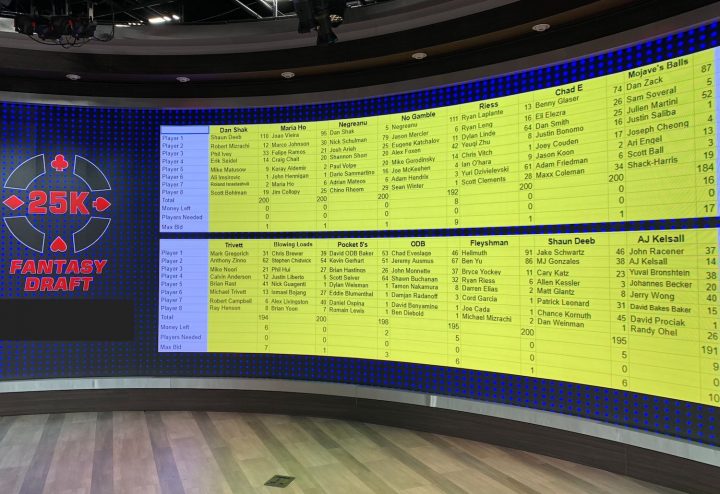Poker is one part card luck and one part analysis and skill. We have no control over what cards are drawn in the flop, the cards other players get, and the cards we get in our hand. All we can do with our cards is try to make the best possible decision to form strong hands and outwit our opponents.
So, how do you become a successful poker player with all that luck involved? Well, the truth is that while the card luck is of course a factor, the biggest deciding factor for how rounds play out is the player’s behavior, tactics, psychological warfare, and poker strategies. It’s the human factor and we can use this to our advantage to look for recurring patterns that we can then exploit to turn the flow of a round to our favor.
Below, we take a look at poker patterns including a simple introduction, why they matter, and eight examples of patterns you can start looking for during your tournament poker play.

A Brief Introduction to Poker Patterns
Let’s kick off by understanding the term and the bearing it has on poker game play.
What are Poker Patterns?
Simply put, patterns in poker are recurring actions performed by other players. These can be broken down into several categories including:
- Behavioral
- Psychological
- Physical
- Gameplay
The two broad categories are player actions and player gameplay. For example, people might display certain physical reactions to specific things happening in a game. Or, people often use particular strategies and betting patterns with their cards.
Poker patterns are things you can analyze and use to your advantage to gauge the flow of play, who has strong and weak hands, and how you should proceed with your actions.
Why Do Poker Patters Matter?
Poker patterns and analysis are essential to becoming a better poker player. Yes, you need to understand the intricacies of the cards, probability, and the different hands, but that only takes you so far. The other half of the game is player behavior and knowing how to manipulate and coerce the flow to your advantage.
Poker patterns let you do this.
You can use patterns to judge when other players are bluffing or when they have a strong hand, and you should retreat. You can also use them to know when to play aggressively and to push the advantage. You can’t hope to consistently win simply by playing your own game and relying on your cards – poker is much more than that and this is where patterns make a difference.
Poker Patterns to Study to Improve Your Game
So, we know what poker patterns are and how pivotal they can be, but which ones are worth studying and how can they impact your decision making? Below, you’ll find an overview of some simple but effective poker patterns below that you could incorporate into your strategy.
Changes in Verbal Communication
When playing poker some players barely engage in conversation and may only speak to the dealer. Others may be open and try to engage in conversation or just chatter in general. You can study your opponents and look for verbal communication patterns or changes that could betray a strong or weak hand.
For example, perhaps someone who usually talks regularly has become a little quiet. This could mean they are on the verge of tilting and thus they might start playing more erratically. You can exploit this and use their descent into chaos to your advantage.
Simply put, humans have a hard time genuinely hiding emotions such as elation or distress and this holds true for poker games. You need to be on the ball with this and look for patterns in communication and emotions to gauge your current standing.
Nonverbal Tells
While verbal patterns can be useful, so can the nonverbal actions of players. These could be anything from fidgeting with hands when under pressure, nervous twitches, faster play with a weak hand, or slower, purposeful player with a strong hand.
When playing poker, you have to be as much of a psychologist as you do a card player. Some players are very good at keeping their physical actions neutral, but others simply can’t hide their emotions.
Taking Info from Unnecessary Showdowns
When playing at live poker events, it’s important to remember that you only have to show your hand during a showdown if it was called on the last round of betting.
Regardless, it mystifies me that many players still reveal their hand at the showdown regardless of if they need to or not. You can use this to your advantage and look for people who always show.
Take a look at the hand they had and see if you can spot any patterns relating to when they typically fold or raise for example. They might not see an issue with showing their hand, but you can use this innocence to your advantage and potentially gain an edge.
Actions While Waiting for Action
You can glean much information from people even before the action reaches them simply by looking at their facial expressions and mannerisms. We like to check for “early lookers” – players who typically look at their hand before the action has reached them.
Most poker players do this – it’s natural to want to look at your cards as early as possible to start formulating a plan. However, this is often a time when a player’s guard is down – they know the action is on the current position and thus aren’t attracting attention.
This means that sometimes they can give away the strength of their hand, or even start to telegraph what they intend to do when it’s their turn. Simply put, if you are in a middle or late position, try and study the behavior of players waiting for their turn to see if you can get any nuggets of info about the strength of their hand.
Check Tactics Poker Patterns
The Check-Raise is a classic tactic and one of the first moves you should learn when playing games like Texas Hold’Em. Aside from using this tactic yourself, it’s also important to analyze the check tactics of other players to spot patterns.
For example, perhaps one player always uses the check-raise move when they are bluffing, but never when they have a strong hand. Newer players will be more predictable with their check-raise moves and can be easier to spot patterns whereas more seasoned players will vary their checking tactics to throw you off guard and prevent patterns from being recognized.
Overbetting
Some players frequently overbet to raise the pot value, play aggressively, and put pressure on the other players. The pattern here is deciphering if the overbettor is doing this because they have a strong hand and want to get as much value as possible, or because they are bluffing and trying to get other players to fold.
This isn’t always obvious and the best poker players will change tactics and switch up their overbetting to avoid patterns being detected. However, oftentimes it’s difficult for humans to break habits and this is where a pattern may emerge.
For example, you may notice that a particular player always overbets as part of a bluffing strategy and thus can use this to call their bluff and cause a huge loss.
Strong Hand Patterns
No matter how hard we try, poker players often have tells or particular patterns when they have what they think is a winning hand. It’s important to look for strong hand patterns so you know when to play aggressive and push them, or when to back off.
For example, many poker players that have nut hands may subconsciously bet aggressively and appear more confident in their actions. They will also usually try and get as much value as possible from the round because they perceive that this is their big pay day.
The downside though, is that aggressive and confident play can also be a bluff so it’s important to recognize the pattern and learn to differentiate between a real strong hand, or a bluffed weak hand.
Weak Hand Patterns
Similar to strong hand patterns, players often subconsciously give signals that they have a weak hand or are not confident about their standing in the round. This could be things such as hesitation, negative facial expressions, or frequent draws.
When confronted with weak hands, some players will simply fold and not engage in any tactics – you can spot this and take advantage by pushing them or playing aggressively as you know they have a tendency to collapse.
In contrast, other players with weak hands will bluff and try to convince you they are a front runner. You have to distinguish between these types of players and look for the patterns that show which one they are.
Take Your Poker Play to the Next Level and Start Learning Patterns
If you want to improve your play, simply understanding the game rules and best card hands isn’t enough. The best poker players all know how to read their opponents.
They know how to look for recurring patterns – signs of what strategies other players are using, or the strength of the cards they hold. This info is then compartmentalized and used to adjust their own strategies, prey on weaknesses, or know when to back off and fold.
It’s important to realize that this takes time. You aren’t going to instantly start being able to analyze player behavior and spot patterns after a few matches. It’s something you have to work at, but it starts with learning the basic patterns and impact they have.





